|
Keeping Food Cold
by
Bob Brooke
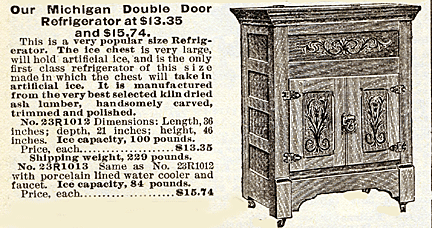 The
traditional ice box dates back to the days of ice harvesting, which
peaked between the 1850s and the 1930s, when manufacturers introduced
the gas-powered refrigerator into American homes. However, the ice box
became such a part of American culture that older people often refer to
their refrigerators as ice boxes. But the real story of the ice box
began in 1802. The
traditional ice box dates back to the days of ice harvesting, which
peaked between the 1850s and the 1930s, when manufacturers introduced
the gas-powered refrigerator into American homes. However, the ice box
became such a part of American culture that older people often refer to
their refrigerators as ice boxes. But the real story of the ice box
began in 1802.
Ice Box History
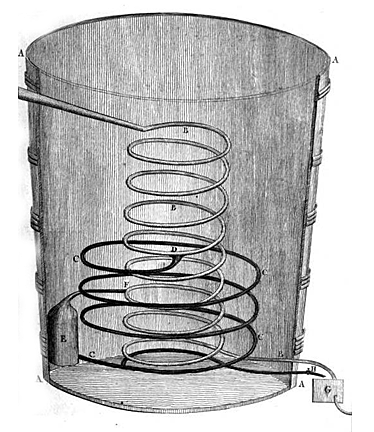 Back
then, an American farmer and cabinetmaker, Thomas Moore, needed to
figure out a way to get his butter to market in solid chunks rather than
a melted mass. He experimented with various methods until he came up
with an ingenious solutionóthe ice box. His first design consisted of an
oval cedar tub with a tin container fitted inside with ice between them,
all wrapped in rabbit fur to insulate the device. Later versions
included hollow walls that were lined with tin or zinc and packed with
various insulating materials such as cork, sawdust, straw or seaweed. He
placed a large block of ice in a tray near the top, so cold air could
circulate down and around the tin storage compartment. Moore used his
device to transport butter from his home to the Georgetown markets,
allowing him to sell firm, brick butter instead of soft, melted tubs
like his fellow vendors. Back
then, an American farmer and cabinetmaker, Thomas Moore, needed to
figure out a way to get his butter to market in solid chunks rather than
a melted mass. He experimented with various methods until he came up
with an ingenious solutionóthe ice box. His first design consisted of an
oval cedar tub with a tin container fitted inside with ice between them,
all wrapped in rabbit fur to insulate the device. Later versions
included hollow walls that were lined with tin or zinc and packed with
various insulating materials such as cork, sawdust, straw or seaweed. He
placed a large block of ice in a tray near the top, so cold air could
circulate down and around the tin storage compartment. Moore used his
device to transport butter from his home to the Georgetown markets,
allowing him to sell firm, brick butter instead of soft, melted tubs
like his fellow vendors.
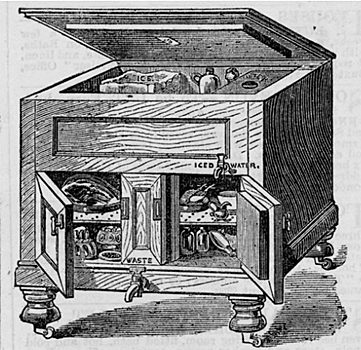 By
1830, Moore refined his design by making a wooden cabinet, similar to a
large dresser, of hardwoods such as oak or walnut. As with his earlier
versions, he lined the cabinet with zinc or tin, packed with insulating
materials such as straw, flax, sawdust, cork, mineral wool, or charcoal.
He tried each material to see which worked best, eventually settling on
zinc. By
1830, Moore refined his design by making a wooden cabinet, similar to a
large dresser, of hardwoods such as oak or walnut. As with his earlier
versions, he lined the cabinet with zinc or tin, packed with insulating
materials such as straw, flax, sawdust, cork, mineral wool, or charcoal.
He tried each material to see which worked best, eventually settling on
zinc.
Moore added several storage compartments inside the cabinet, with doors
to each, including the ice compartment. He placed a drainage hole in it
so that melted water, collected in a tray, could be emptied daily. Other
ice box makers added spigots for draining the ice water.
The user had to replenish the melted ice, normally by obtaining new ice
from an iceman, who delivered it by horse and wagon. The design of the
ice box allowed perishable foods to be stored longer than before and
without the need for lengthy preservation processes such as canning,
drying, or smoking. Refrigerating perishables also had the added benefit
of not altering the taste of what was preserved.
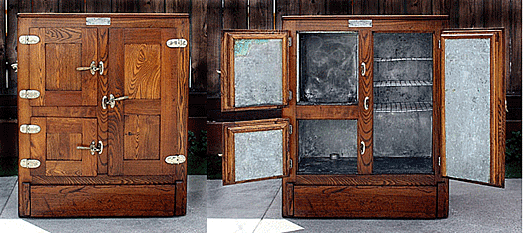
Until the late 1820s, cabinetmakers made ice boxes to order. But by the
1840s, various companies appeared including Sears & Roebuck, The Baldwin
Refrigerator Company, and the Ranney Refrigerator Company began to mass
produce ice boxes. Historians consider D. Eddy & Son of Boston to be the
first company to produce ice boxes in large quantities. During this
time, many Americans desired big ice boxes. Such companies like the
Boston Scientific Refrigerator Company, introduced ice boxes which could
hold up to 50 lbs of ice. A survey of New York City residents in 1907
found that 81 percent of the families surveyed owned some form of ice
box.
Harvesting Ice
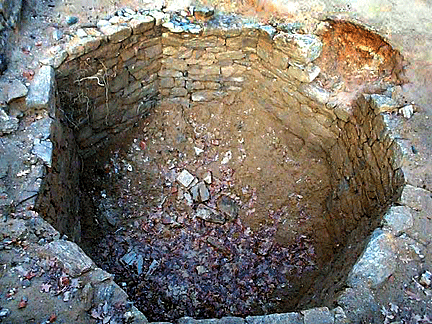 Before
the advent of ice collection in the early 19th century, people used
underground pits to store ice. These had a constant temperature of 54
degrees F. and helped preserve the ice that had been collected during
the winter. They also were a great place to store perishable goods. The
pits had to be dug below the frost line, usually 3 to 5 feet below the
surface. Besides providing good insulation, they also deterred animals
from getting to the perishable items stored within. Homeowners lined the
pits with straw and sawdust compacted along the sides of the ice to
provide further insulation and slow the ice melting process. Before
the advent of ice collection in the early 19th century, people used
underground pits to store ice. These had a constant temperature of 54
degrees F. and helped preserve the ice that had been collected during
the winter. They also were a great place to store perishable goods. The
pits had to be dug below the frost line, usually 3 to 5 feet below the
surface. Besides providing good insulation, they also deterred animals
from getting to the perishable items stored within. Homeowners lined the
pits with straw and sawdust compacted along the sides of the ice to
provide further insulation and slow the ice melting process.
In 1827, the invention of the commercial ice cutter increased the ease
and efficiency of harvesting natural ice. This invention made ice
cheaper and, in turn, helped the ice box become more common.
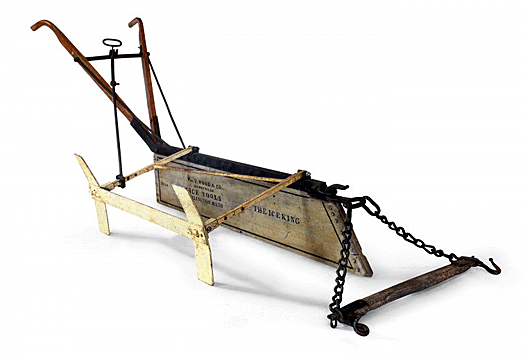
As the ice box began to make its way into homes during the early to mid
19th century, ice collection and distribution expanded and soon became a
global industry. During the latter half of the 19th century, natural ice
became the second most important US export by value, after cotton.
 Workers
harvested the ice in winter from snow-packed areas or frozen lakes. Then
they brought the ice to ice houses by horse and wagon or sleigh for it
to be stored. Eventually, they used motorized trucks.. Workers
harvested the ice in winter from snow-packed areas or frozen lakes. Then
they brought the ice to ice houses by horse and wagon or sleigh for it
to be stored. Eventually, they used motorized trucks..
By the 1930s, most residential homeowners began replacing their ice
boxes with refrigerators. However, not all households could afford the
luxury of electric refrigerators, especially during the Great
Depression.
As more households adopted the ice box, the overall quality and
freshness of food improved. Ice boxes enabled people to go to the market
less and store leftovers more safely. All of this contributed to the
improvement of the peopleís health by increasing the fresh food readily
able, as well as its overall safety. However, with urban growth, many
sources of natural ice became contaminated from industrial pollution or
sewer runoff, necessitating the switch from ice boxes using blocks of
ice to gas-powered refrigerators.
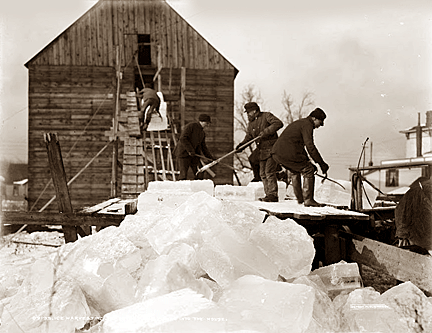
Antique Ice Box Market Value
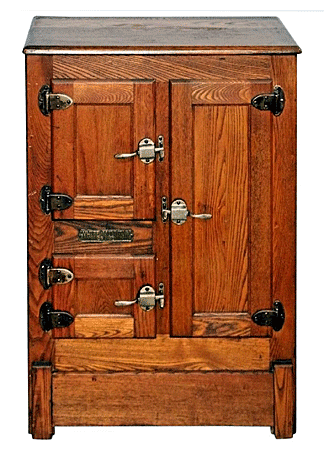 Depending
on the condition, an antique wooden ice box can be worth a lot of money.
Many restored ice boxes now sell for as much as $2,000 to $3,000. Itís
even possible to buy a restored antique wooden ice box that has been
converted into a refrigerator or wine cooler with modern refrigeration
equipment. Depending
on the condition, an antique wooden ice box can be worth a lot of money.
Many restored ice boxes now sell for as much as $2,000 to $3,000. Itís
even possible to buy a restored antique wooden ice box that has been
converted into a refrigerator or wine cooler with modern refrigeration
equipment.
The usability of an antique ice box determines its actual market value
The ice boxís age, size, condition, material, authenticity and
provenance all contribute to its value.
Even a properly restored or professionally refinished ice box can be a
good buy.
While a restored or refinished model can sell for as little as $2,000,
extremely rare ice boxes in good condition can cost as much as $10,000.
With those prices, itís a good idea to make sure an ice box is worth it.
Early ice boxes didnít feature top-quality structure, so quality will
vary. Itís important to check the wooden surface closely to detect signs
of deterioration, such as visible cracks, chips, scratches, and warps.
All of these add to the originality of the ice box. Reproductions are
common, and many get sold as antiques.
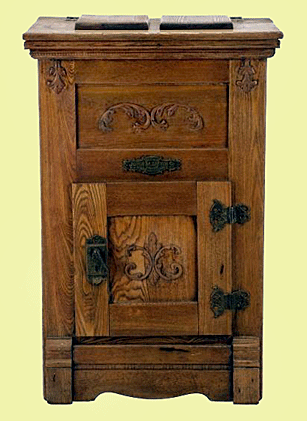 Also,
when purchasing an antique ice box, a buyer should settle for a simple
design with a minimal number of compartments. Too many storage spaces
with ornate designs indicate itís a reproduction. Also,
when purchasing an antique ice box, a buyer should settle for a simple
design with a minimal number of compartments. Too many storage spaces
with ornate designs indicate itís a reproduction.
Itís also a good idea to check for the finishing on the edges which may
offer clues to classic wooden pieces. The type of joinery use will
indicate old-school craftsmanship. . Joining, screws, nuts, bolts must
feature deteriorating rust over time. Remember, cabinetmakers
constructed early ice boxes individually.
Next, check the interior insulation. Minimal finishing can appear on the
sides to hold insulating materials. Itís also important to determine the
condition or functionality of the insulating materials. Early materials
should have aged out long ago.
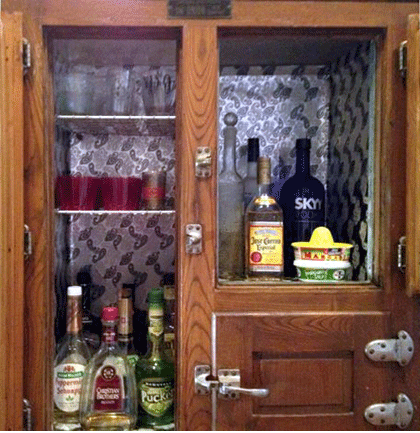 Explore
the slot to allow drainage of the melted water from the compartments.
Genuine antique ice boxes should have marks indicating previous use. Explore
the slot to allow drainage of the melted water from the compartments.
Genuine antique ice boxes should have marks indicating previous use.
Look for rust on interior surfaces. This is a sure sign that it has been
covered in galvanized steel.
Many people who purchase antique ice boxes repurpose them to store all
sorts of items without disturbing the integrity of the original ice box.
Most people donít purchase more than one ice box. Itís a piece of
antique furniture and should be treated as such.
<
Back to Antiques Archives
Next Article > |
